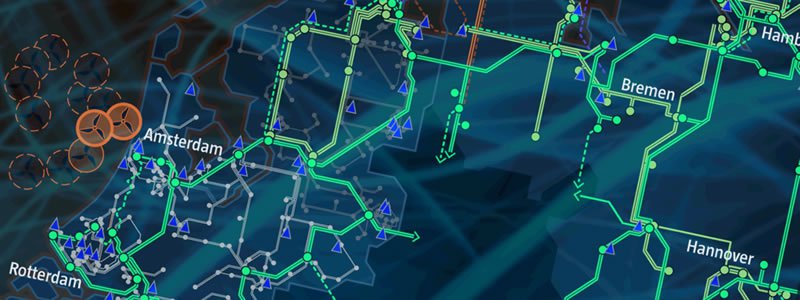
COPENHAGEN – Storage in electric vehicles or home batteries. Postponed consumption of industries and households. Agro CHP’s helping to prevent overloads. Or blockchain to help combine small suppliers on the power grid. The increasing supply of renewable energy demands more flexibility solutions to prevent future power shortages and failures on the European grid.
To raise awareness for these challenges and to explore solutions, major stakeholders and experts from various countries come together at the first Energy Flexibility Forum (EFF) in Copenhagen at the 11th and 12th of June. During the two day conference and exhibition, organised by Solarplaza, they specify their needs and showcase their solutions, thus accelerating the sustainable energy transition.
To keep the power grid running stable at a frequency of 50 Hertz, the supply of electricity fed into the system has to match the demand. All large producers and consumers of electricity have to indicate their supply and demand one day ahead, so Transmission System Operators (TSO) can maintain the balance on the grid.
At the end of April power producers in the Netherlands had large deviations from their actual demand and consumption versus their forecasts, causing a power shortage on the Dutch grid. This forced TSO Tennet to rapidly buy electricity on foreign markets in order to prevent power failure. "This case became national news, but this happens more often. For instance when a coal or gas fired power plant trips. It is our job to solve this, as we did by buying power in Germany and Belgium,” says Anton Tijdink, electricity market analyst at Tennet.
However, these problems may occur more often in the future, because power generation is shifting from centralised fossil fuelled generation to decentralised renewable generation. The growth of variable wind and solar generation and electrification of energy demand will lead to an increasing demand for flexibility.
"Wind and solar bring more volatility to the market,” says Tijdink. "You can start up or shut down a gas power plant, but if the sun doesn’t shine you don’t have power.”
That is why flexibility assets such as demand response, storage and flexible generation are needed to complement wind and solar.
"In the future it is possible consumers opt for price for their electricity that differs every 15 minutes."
Tennet, owner of the Dutch- and large parts of the German high-voltage grid, recently released its Flexibility Roadmap. In this report the TSO describes dozens of measures that can be taken. In times of power shortages large scale energy consumers like industrial electrochemical processes and residential heat pumps can reduce their demand. When renewable energy production is high, flexible consumption is switched on, home batteries and batteries of electric vehicles are charged and hydrogen is produced in the industry to storage power. "You have to control this through smart management. In the future it is possible consumers opt for price for their electricity that differs every 15 minutes,” Tijdink says.
Tennet started several pilot projects. In collaboration with the German Sonnen Gruppe it succeeded in integrating decentralised domestic solar batteries into the grid. In the Netherlands Tennet in collaboration with Vandebron uses the capacity of car batteries to keep the balance between power consumption and production stable. "At the moment there are maybe a hundred Tesla’s participating in this pilot, but in the future there will be over a million electric vehicles. If they increase and decrease their charging pattern in response to the imbalance in the system, they can represent an alternative to the conventional power plants that currently fulfil this important task,” says Tijdink.
In both pilots blockchain technology helped to integrate flexible capacity of household batteries and charging points of electric cars, by sharing reliable information about who supplied what. Tennet also started collaboration with numerous other market parties, among which CrowdNett, a Dutch network of smart home batteries, powered by solar energy. Together they can supply multiple megawatts to the grid.
In the Netherlands the horticulture sector is an active participant in the energy market and already a major provider of flexibility, through a combination of CHP power installations, heat buffering and demand response of lighting. When the limit of the transfer capacity of the grid is reached, Distribution System Operator (DSO) Stedin can ask the farmers to increase the power generated by their CHP’s. That is called congestion management.
"Our medium-voltage grid can face problems in certain areas when it reached its maximum capacity. For instance when large industries suddenly start up. Then we have to buy flexible power services,” says Michiel van den Berge, innovation project leader at Stedin.
"We used to have one-way traffic on the grid. Now we have two-way or even six-way traffic. That is one of the main reasonswhy we need flexibility."
Battery discharges can also solve these problems. That’s why Stedin is about to issue a tender for parties with – a combination of – batteries. The DSO also runs pilot projects like in city district Lombok in Utrecht, where electric car batteries are used for storage and flexible supply. ,,An electric vehicle can charge as much power as four households use in just a few hours,” van den Berge says. "Charging or discharging the battery can help maintain balance on the grid.”
Van den Berge guides Stedin in developing a stabile future grid by scanning the market for flex-potential. He also uses blockchain technology in another project at Hoogdalem, for instance to build a network to combine small suppliers. "To obtain a smart grid we need information and more data,” he says. "Predicting the generated amount of power will be more difficult, because renewable energy depends on the weather. We used to have one-way traffic on the grid. Now we have two-way or even six-way traffic. That is one of the main reasons why we need flexibility,” he says.
